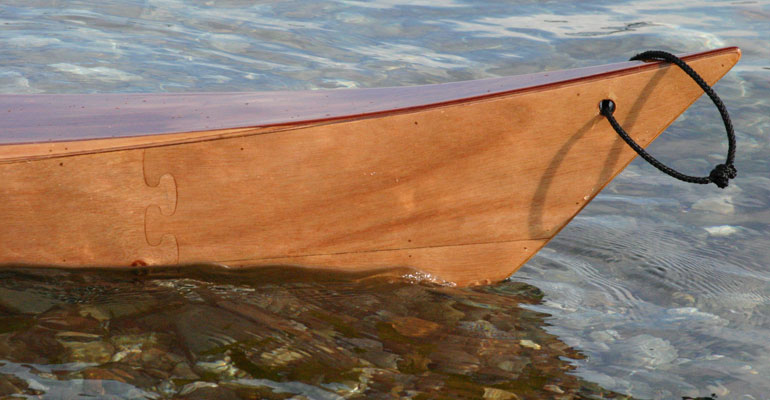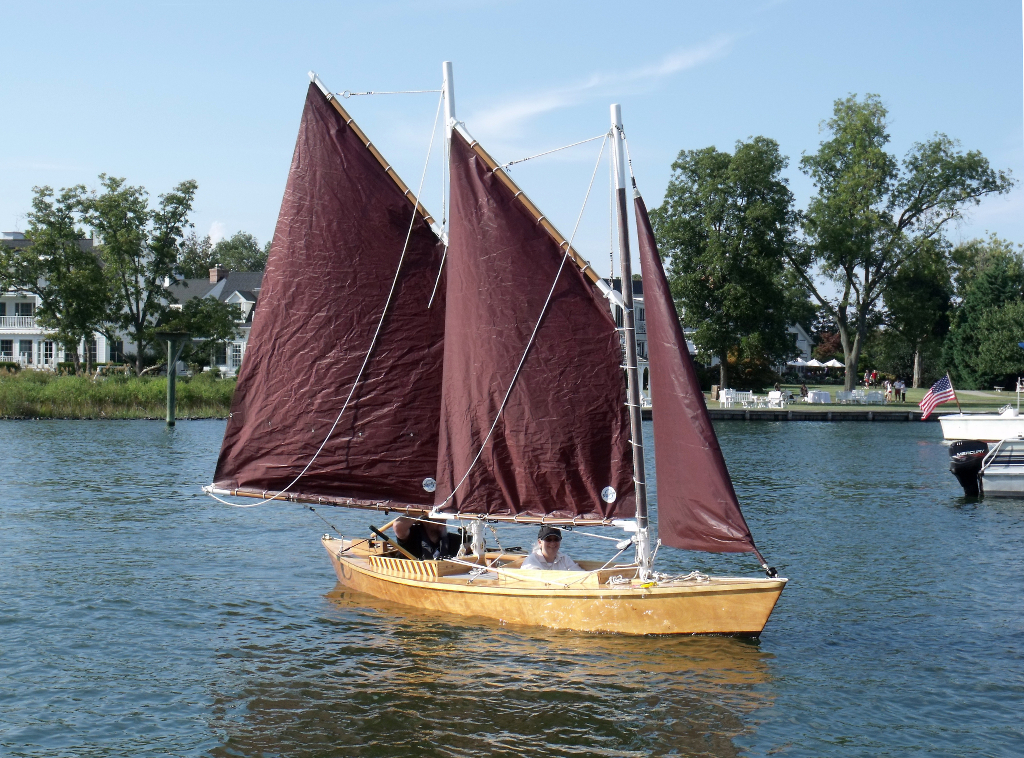Builders' Forum |
|
| ↓ Scroll to Last Comment ↓ | Forum Guidelines | Builders' Forum | |
I am working on a Kaholo 14 kit and just finished my first puzzle joint.
I am curious as to why the kit uses puzzle joints and not scarfs on the plywood pieces. I have to admit I find them more tedious and difficult to work with than a scarf and I think they really detract from the beauty of the finished product.
21 replies:
RE: Why puzzle joints?
Seth,
I am not familiar with size of Kaholo puzzle joints. I purchased mahogany veneer and came up with a design to cover my Chesapeake’s deck puzzle joint. I used the CLC instructions for their onlays to glue it on before I fiberglassed. I put on more than one onlay and found it much easier to use a very thin layer of glue. I actually used five-minute epoxy for most of the onlays and it worked very well but they were all small onlays. A larger onlay might require more time to position properly but I would still use only a thin layer of glue. The glue only needs to hold it until you epoxy over the onlay and then fiberglass it into place.
Mike
RE: Why puzzle joints?
Thanks for the input, I was just curious. I did a Mill Creek 16.5' many years ago and I am pretty sure it had pre-cut scarfs on the side and bottom panels.
I suppose it makes sense that the puzzle is easier to machine than the scarf.
RE: Why puzzle joints?
We milled scarf joints on most boats up until about ten years ago. Since then the whole fleet has switched to puzzle joints.
It's possible I've cut and glued more scarf joints than anyone alive. When they're perfect, they're great, but they're really hard to get perfect. Even more so in a volume production setting.
The biggest problem was not the scarf joint itself, but the fact that the panels required somewhat exacting alignment when they were glued. A stringline was pulled and measurements taken, etc. If the panels were slightly misaligned, strange and unpredictable things could and did happen to stitched-and-glued hull shapes. Such misalignments rarely affected performance or appearance, but it could make bulkheads not fit properly and so on.
Puzzle joints eliminate the panel alignment step. The upshot has been an order-of-magnitude improvement in the ease of hull assembly. Now there is essentially zero variation in hull shape from one builder to the next. A nice trick to pull off when the boats aren't built on molds.
Scarf joints in plywood are also frail to be packed and shipped through the mail, and to move around in the shop. We must have replaced a thousand panels with scarf joints damaged in shipping. Puzzle joints are much more rugged both in shipping and on the shop floor.
Since the CNC machine has to slow down when it cuts the puzzle joint, 25 puzzle joints take longer to cut than 25 scarf joints using our old scarfing machine. But count scarfed parts rejected due to defects or shipping damage, and allow that puzzle joints are about three times faster to glue up, and puzzle joints win by a nautical mile.
Are puzzle joints as pretty as a perfect scarf joint? Subjective. The vast majority like the look of puzzle joints, though once in awhile I'll get a furious traditional boatbuilder on the line who was expecting scarf joints. What's not subjective is that the average puzzle joint looks a lot better than a rough scarf joint!

RE: Why puzzle joints?
I invariably build from plans. I can't get 8' x 4' sheets of plywood (2.2m x 1.7m here) so usually have 2 scarf joints in each panel that is over 14' long. If I could have puzzle joints I'd bite your arm off for them. I toyed with the idea of a sort of dovetail joint but scarphs are easier.
I'm not a traditional boat builder, I'm just stuck with what I've got.
RE: Why puzzle joints?
I hasten to add that my comments refer to kit-built boats, not plans-built boats.
Scarfs are THE BEST way to handle a plans-built boat.
Since you're creating "blanks" first and then cutting out the parts, my comments about panel alignment don't apply to plans builders. There are no concerns about misalignment.
RE: Why puzzle joints?
���Thanks a lot for the detailed reply John! I can appreciate the improvements over the scarf, it seems like a well thought out decision. My only gripe with the puzzle joint is that it looks so clearly machined where the rest of the boat has a more natural look. But I am not complaining, I knew what I was getting when I ordered. Either way, I glued the sheer clamps up to the side panels today and I am very excited to start stitching them into the frames tomorrow!
RE: Why puzzle joints?
It's not often that I disagree with John, but I think that puzzle joints are actually superior for plans building. Getting pre-cut joints eliminates all the hassles of making the scarphs. CLC, in fact, sells plywood sheets pre-cut with puzzle joints that let you make continuous sheets of plywood of essentially infinite length. The joints are very tight. I was able to pick up 1/4 inch plywood where I'd just pressed the joints together (no glue) and they did not come apart.
I built my scratch-built 18-ft schooner using them and it came out looking well enough to win some prizes. The initial assembly went much faster than if I'd had to have scarphed the panels.
To sethdingwell's point about looking machined vs. natural - a perfect scarph is a perfectly straight thin line, which is the most unnatural construct of all.
Have fun all,
Laszlo


RE: Why puzzle joints?
A cool compromise may be to make the puzzle joints irregular. I'm sure Mr Harris's intent is to make the joints as strong as possible and to fit within the constraints of the 3 inch tape. Perhaps a wider joint tape could allow for some very organic shapes that our brains would be less likely to recognize as a joint. I think the reason our eyes are drawn to the puzzle joints is the regular pattern they form. Our brains are very good at recognizing pattern and focusing our attention towards them.
I too was a little annoyed by the joints at first, but the more I look at them the more I like them. Definately a good compromise for ease of building. I cant imagine what a PITA it would be to have to deal with scarf joints in building my camper.
RE: Why puzzle joints?
Done3 boats with scarfs and 2 with puzzle joints and I find the puzzle joints way easier especialy since those particular kits have all the wire holes pre drilled there's no measuring for me to screw up
RE: Why puzzle joints?
I have to admit that I'm one of those folks that don't really care for the appearance of puzzle joints on boats that are finished bright. With that being said, I totally understand and appreciate the benefits in a kit. With that being said, I looked at a box joint jig that Rockler sells that has evenly spaced fingers that I might possibly use to create my own psuedo-puzzle joint for my plans built Passagemaker. In the end, the lure of succeeding at the classic technique of making the scarf joints won out.
RE: Why puzzle joints?
Traditional scarfs done in solid timber were a means to an end when there was no alternative.
A well-made scarf is a pleasure to see whether plain, haunched or stepped, but the execution really is more a labor of love than a necessity in this age of plywood & epoxy craft.
Knowing how to achieve a well-made scarf is a useful skill to acquire (akin to achieving a truly sharp AND durable edge on our edged tools for many of us) while puzzle joints make a worthwhile contribution (and a welcome attribute in either kit form or in full-sheet raw material) for those who'd rather avoid the time it takes to make traditional scarfs.
Puzzle joints in plywood to my thinking are the CNC equivalent of traditional scarfs, now easily rendered by virtue of the marriage of computers to woodworking technology and folks like John H.
RE: Why puzzle joints?
The old CLC kits used scarf joints and I honestly liked the look better when finished natural. I think the puzzle joints are supposed to be easier to put together but it is possible to screw them up too. When I build from plans I use butt joints on everything rather than trying to scarf the plywood which is the way Pygmy boats does their kits.
RE: Why puzzle joints?
For those who don't like the look of puzzle joints, try a strategic paint pattern. I scarfed my plans-built kaholo but the scarfs weren't perfect looking so i put a nice red section in the middle of the board and it looks perfect.
RE: Why puzzle joints?
Count me as a fan of the puzzle joint, aesthetically and technically. I like it on my Struer ICF C1 and I like it on my CLC dory.
RE: Why puzzle joints?
I can understand the appeal of a puzzle joint for all the reasons you mentioned. I am sure you hear this occassionally from weirdos like me but I just can't stand looking at them! I know it is a completely irrational reaction, but what can I say.
I was thinking of building another boat (the last CLC boat I built was around 2004 I think). If puzzles are the only option I know I'll build from plans. I figured it would be worth asking though - are scarfs available as a custom kit option?
RE: Why puzzle joints?
Bob,
You may get a faster answer if you use the "Contact Us" link at the top of the page. But let us know what you find out if you do.
Laszlo
RE: Why puzzle joints?
While I like the strength and ease of assemble of the puzzle joints I am not a fan of the appearance. I think that it would help if they wre not aligned vertically but were instead offset as in laying bricks. I believe that this would add strength as well as break up the pattern. I will be glad to soon be assembling my Chester Yawl pannels and not worrying about getting them straight! Cheers!
RE: Why puzzle joints?
>>>are scarfs available as a custom kit option?
Sure, we've done that for folks like yourself.
Alas, YOU would have to plane the scarfs, however. The request has become rare enough that our old scarfing machine has been retired to storage. But we could blank out the puzzle joints easily enough.













RE: Why puzzle joints?
» Submitted by Dick Dowdell - Mon, 11/14/16 » 9:19 AM
Seth,
Puzzle joints are made possible by the CNC cutting of plywood sheets. They are far less expensive to manufacture than planed scarfs and are easier to align properly and at least as strong, if not stronger.
I am unaware of any pre-cut plywood kits that come with planed scarfs. They would add to the kit cost and their sharp edges would be prone to shipping damage.
As to the aesthetics, that is a matter of individual taste. However, if you want planed scarf joints, you'll probably have to build from plans not a kit.
Cheers,
Dick